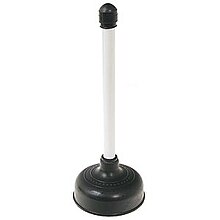Just how do you feel on the subject of How To Use Your Toilet Plunger Correctly in 5 Easy Steps?

Intro
Appropriate maintenance of home drains is essential for avoiding clogs and making sure smooth water circulation. One of the trick devices in every house owner's toolkit is the bettor, together with different drainpipe cleansers designed to take on persistent clogs efficiently. This article discovers exactly how to utilize plungers and drainpipe cleansers efficiently to maintain your drains moving easily.
Area 1: Understanding Bettors
Sorts of Plungers
There are a number of kinds of bettors available, each created for various types of drains and blocks. One of the most common types include mug bettors, flange bettors, and accordion plungers.
How Plungers Work
Plungers service the concept of developing stress and suction to dislodge clogs. When correctly applied over a drain, they produce a vacuum that can pull out debris or break up clogs.
Picking the Right Bettor
Picking the ideal bettor depends upon the kind of drain and the nature of the clog. Mug bettors are excellent for sinks and tubs, while flange plungers are better suited for commodes because of their design.
Typical Errors with Plungers
Preventing these mistakes makes sure efficient plunging: improper seal around the drain, inadequate force, and not clearing bordering particles.
Area 2: Making Use Of Plungers Successfully
Prep work
Before plunging, guarantee the plunger covers the drainpipe entirely and develops a tight seal. Clear any visible particles around the drain opening.
Technique
Beginning with mild plunging motions to construct suction. Boost pressure progressively, utilizing a steady rhythm. Repeat as essential up until the drain removes.
Troubleshooting Tips
If diving doesn't function, try changing the seal, applying petroleum jelly for a far better seal, or utilizing a various kind of bettor.
Area 3: Comprehending Drain Cleaning Company
Kinds Of Drainpipe Cleaning Company
Drain pipes cleansers can be chemical or chemical. Chemical cleansers utilize strong chemicals to dissolve clogs, while enzymatic cleansers utilize natural enzymes to break down organic matter.
How Drain Cleansers Work
Chemical cleaners respond with clogs to liquify them, while chemical cleaners break down organic materials like hair and grease without harming pipelines.
Security Considerations
Constantly use handwear covers and eye defense when making use of chemical drainpipe cleaners. Guarantee ample ventilation and adhere to producer instructions meticulously.
Eco-Friendly Alternatives
Consider using vinegar and baking soda or enzyme-based cleaners for environment-friendly options that are much safer for pipes and the atmosphere.
Area 4: Utilizing Drain Cleansers Successfully
Application Methods
Pour chemical cleaners straight right into the drain opening. Enable them to work for the recommended time before flushing with hot water. Chemical cleaners must sit over night.
Preventative measures
Stay clear of blending different types of cleaners, as this can create toxic fumes. Never ever make use of chemical cleansers along with a plunger, as spilling can occur.
Handling Stubborn Obstructions
For relentless clogs, think about utilizing a pipes serpent or calling a specialist plumbing to avoid damages to pipelines.
Final thought
Finally, understanding just how to use bettors and drain cleaners efficiently is crucial for keeping healthy and balanced pipes systems. By selecting the right tools and techniques, home owners can tackle small blockages and stop significant pipes problems down the line.
4 DIY Ways to Unclog Drains
Wire Hanger
This age-old technique has been used by many an amateur plumber – to much success. Take any wire hanger, deconstruct its shape and leave a small hook shape on the end. Time to go fishing! Remove the shower or sink drain cover and snake the wire into the drain, wiggling and rotating it as you push it through. Dispose of the gunk that you remove and flush the drain with hot water. Rinse with a pan of boiling water for best results.
Plunger
Creating a suction in your drain can break up clogs caused by hair and soap residue build up. First, make sure you are using the correct type of plunger, one specifically for sinks or tubs. They are typically smaller than regular toilet plungers and often have a shallow suction cup. Regular plungers can work too but we’d recommend cleaning them first and finding a way to create better suction over the drain.
Baking Soda and Vinegar
This technique is a classic – and one of the most popular DIY drain unclog methods. Pour one cup of baking soda and one cup of vinegar down the drain and allow it to work its magic overnight. The next morning, flush the drain with boiling water. Repeat if necessary.
Drain Snake/Hair Clog Tool
If you know your clog is caused primary by hair, a drain snake/hair clog tool might be your best option. These tools can be purchased for under $10 at any hardware store and work well so long as the clog isn’t too deep in the drain.
https://www.callcatons.com/blog/four-diy-ways-to-unclog-drains/

We had been shown that write-up on Here's How to Correctly Use a Toilet Plunger from an acquaintance on our other domain. Do you know somebody else who is interested by How To Use Your Toilet Plunger Correctly in 5 Easy Steps? Why not promote it. Thank you for taking the time to read it.
Call Today
Comments on “Master Plungers and Drain Cleaners Methods: Expert Guidance”